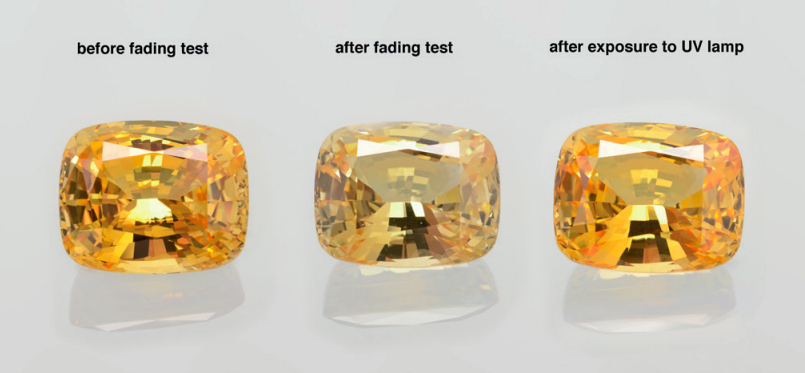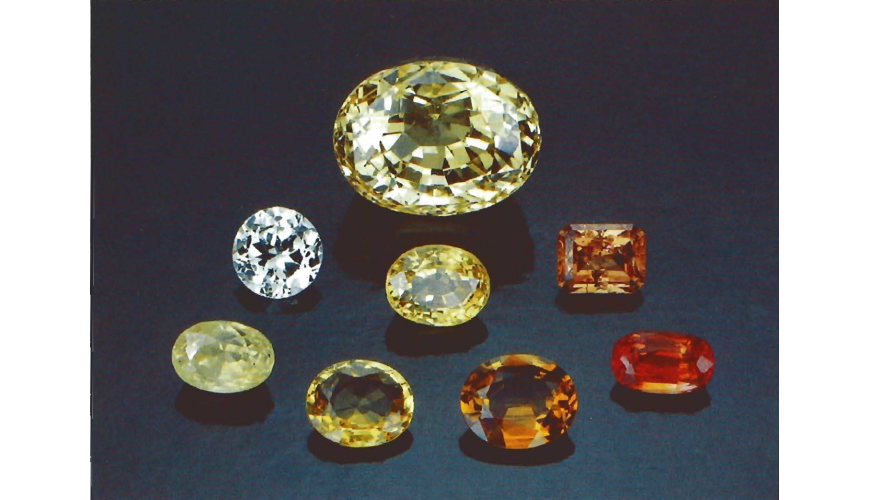THE SEVEN TYPES OF YELLOW SAPPHIRES
THE SEVEN TYPES OF YELLOW SAPPHIRE AND THEIR STABILITY TO LIGHT
By Kurt Nassau and G. Kay Valente
Dr. Nassau is a research scientist residing in Bernardsville, New Jersey; Ms. Valente is vice-president of American Gem Market System, Moraga, California. Acknowledgments: The authors gratefully acknowledge the loan of study material from R. C. Miller and G. V Rogers, both of New York City; from R. Vinyard, of Lake Oswego, OR; and from the Gemological Institute of America, Santa Monica, CA. The GIA Research Department was also extremely helpful.
==================================================================================

==================================================================================
- Type 1: Natural stable color center
- Type 2: Natural or laboratory-irradiated fading color center
- Type 3: Natural iron-produced stable color
- Type 4: Heat-developed stable color
- Type 5: Surface-diffused additive color
- Type 6: Synthetic with impurity-caused color
- Type 7: Synthetic with irradiated fading color
--------------------------------------------------------------------------------------------------------------------------------------------------------------
Colorless to yellow to intense orange sapphire will react quite differently to light or heat depending on the nature of the material and the origin of the color. The authors determined that there are actually seven types of "yellow" sapphire on the market today, which differ in the cause of color and the stability of the color to light: type I -natural, light-stable color center; type 2-natural or irradiation- produced, fading color center; type 3-iron containing, not heated, light stable; type 4-iron containing, heated, light stable; type 5-surface-diffused additive, light stable; type 6 -synthetic, light stable; and type 7-synthetic irradiated, fading. The authors examined more than 150 samples of yellow sapphire to confirm the seven types and document their different reactions to light, heat, and/or irradiation. One unexpected finding was that type 1 material can fade on heating even below 200°C, but thin the color is restored by exposure to light.
.
Yellow sapphires have surged in popularity in recent years, which has prompted further study into their properties and, especially, the effects of treatment by heat or irradiation. An important problem is a distinction between yellow sapphires that are color stable and those that fade under normal conditions. At present, the only practical way for the gemologist to separate these two materials is by an extended exposure to light or by some sort of heating test. Webster and Anderson (1983) suggest that three hours in bright sunlight or a few minutes of heating at 230° will fade (and thus identify) irradiated Sri Lanka material. Dealers in the Far East routinely test yellow sapphires by heating them in the flame of a candle for a few seconds or placing them on a sunlit windowsill for a few days. A heating test that is too short, however, can be unreliable, since the stone - particularly a large one-may not reach the required temperature; partial fading can also occur with material that is stable to light, as discussed below.
.
In the course of testing the reaction of the color of a wide variety of gem materials with respect to light and heat, one of us (KN) came to note a simple relationship: among all the materials tested, those that fade rapidly on exposure to light also lose their color when heated at 200° for about one hour (e.g., Maxixe-type beryl and some brown topaz), and materials that do not lose their color after one hour at 200° also do not fade significantly in light (e.g., amethyst and smoky quartz, blue and some brown topaz, and red tourmaline]. One obvious anticipated exception is the chameleon diamond, in which one color component appears to fade (Nassau, 1984). As a result of the present work, another one is yellow sapphire. With these two exceptions, heating at 200 C for about one hour can be a useful test for color stability.
=================================================================================
When we became aware of the variable reaction of yellow sapphires to this test, we sought to establish the possible range of reaction of different types of yellow sapphire to light, heat, and irradiation. In the course of this research, we determined the need for distinguishing the various types of yellow sapphire, so a provisional classification system was developed on the basis of our experience and the previous literature. The proposed classification and the research study are described below. A number of yellow sapphires, natural and synthetic, treated and untreated, were tested for their reaction to heat, light, and irradiation. The research confirmed the proposed classification system; recognition of the seven types will permit the gemologist to deduce for any yellow sapphire* both the color origin and the stability of the color to light and to heat exposure by conventional gemological testing.
.
To read the full research article by By Dr. Kurt Nassau and G. Kay Valente

....... Click Here





